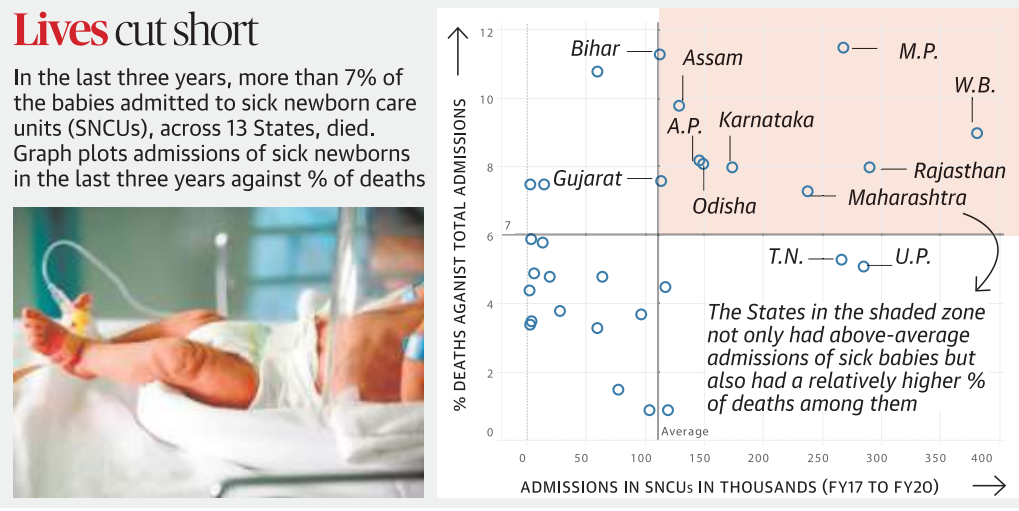Governance
Increasing Neonatal Deaths in MP
- 17 Feb 2020
- 5 min read
Why in News
According to the National Health Mission (NHM) data, Madhya Pradesh has recorded the highest percentage of newborn deaths at 11.5% against the total admissions to government-run Sick Newborn Care Units (SNCUs) in the past three years across the country.
- The country’s average percentage of newborn deaths is at 7 %.
- The neonatal deaths in India mainly occur due to premature births and low birth weight (35.9%), pneumonia (16.9%), birth asphyxia and birth trauma (9.9%), other non-communicable diseases (7.9%), diarrhoea (6.7%), congenital anomalies(4.6%) and infections (4.2%).
NOTE:
According to UNICEF, in India (2018),
- Under 5 Mortality Rate is 39 deaths per 1000 live births.
- Infant Mortality Rate (under one year of age) is 32 deaths per 1000 live births.
- Neonatal Mortality Rate (during the first 28 days of life) is 24 deaths per 1000 live births.
Key Points
- Madhya Pradesh Compared to the National Scenario:
- The admissions of neonates in the hospital of Madhya Pradesh have dropped (lower than West Bengal, Rajasthan and Uttar Pradesh) from April 2017 to December 2019 but the percentage of deaths still remained at 12.2%.
- Within the same time period, West Bengal reported maximum neonatal deaths (34,344) in the country but reported the declining percentage of deaths (from 9.2% in 2017 to 8.9% in 2019) which coincided with a decrease in admissions at hospitals.
- Scenario in Tribal and Rural areas of MP:
- Most tribal (31 out of 51) districts in Madhya Pradesh report low nutrition and weak maternal health levels and thus death percentage of more than 10.
- The absence of community referrals, significantly aided by Accredited Social Health Activist (ASHA) workers is lacking in rural and tribal areas as only one in ten sick neonates born outside a hospital is taken to an SNCU.
- It is majorly due to the absence of transport, inability to identify a disease by parents, and lack of awareness.
- Scenario in Urban Areas:
- Urban areas of Madhya Pradesh report a higher death percentage as they offer tertiary care, and admit several serious cases from peripheral districts.
- Reasons:
- Staff crunch, low community referrals, absence of a special neonatal transport service to health centres, reliance on units in cities as last resort and the non-availability of enough units to cater to increasing institutional deliveries have contributed to the increase in the percentage of deaths.
- Only one against the required five (82% shortfall) of surgeons, gynaecologists, physicians and paediatricians are available at hospitals.
- With increasing institutional deliveries in the State (80.8% as per the National Family Health Survey-4, 2015-2016), the number of neonatal care units has not increased proportionally.
- Sex Ratio in Admissions at Hospitals:
- Madhya Pradesh has recorded an abysmal sex ratio in admission (number of girls admitted against 1,000 boys) at 663 in the three years against the country average of 733.
- More admissions of boys (almost three-fourths of the cases) show a bias against the girl child in society,
- The other reason for the lower admissions of a girl child can be attributed to better immunity among girl children to combat diseases.
- Madhya Pradesh has recorded an abysmal sex ratio in admission (number of girls admitted against 1,000 boys) at 663 in the three years against the country average of 733.
- Cases of Underreporting:
- The NHM data also reveals the cases of underreporting in 43 districts where government officials didn’t report more than 50% of deaths of children under five to keep clean records.
Accredited Social Health Activist (ASHA)
- ASHA is a trained female community health activist. Selected from the community itself and accountable to it, the ASHA works as an interface between the community and the public health system.
- The role of an ASHA is that of a community-level care provider. This includes a mix of tasks: facilitating access to health care services, building awareness about health care entitlements especially amongst the poor and marginalized, promoting healthy behaviours and mobilizing for collective action for better health outcomes and meeting curative care needs as appropriate to the organization of service delivery in that area and compatible with her training and skills.






-min.jpg)